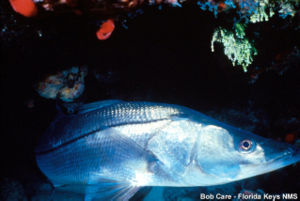- Centropomus
-
Snooks Systematik Teilklasse: Echte Knochenfische (Teleostei) Überordnung: Stachelflosser (Acanthopterygii) Ordnung: Barschartige (Perciformes) Unterordnung: Echte Barsche (Percoidei) Familie: Centropomidae Gattung: Snooks Wissenschaftlicher Name Centropomus Lacepède, 1802 Die Snooks (Centropomus) sind eine Gattung aus der Unterordnung der Echten Barsche (Percoidei). Sie stehen monotypisch in der Familie der Centropomidae. Die bisher zu dieser Familie gezählten Gattungen Lates und Psammoperca werden jetzt in die neu geschaffenen Familie Latidae gestellt.
Inhaltsverzeichnis
Vorkommen
Alle 12 Arten der Snooks leben im subtropischen Nordamerika und in Mittelamerika im küstennahen Meer, im Brackwasser und in Flüssen.
Merkmale
Snooks sind 36 Zentimeter bis 1,40 Meter lange Raubfische, deren barschartiges, langgestrecktes Erscheinungsbild an den europäischen Zander erinnert. Der Unterkiefer ist länger als der Oberkiefer. Das Seitenlinienorgan reicht bis zur gegabelten Schwanzflosse.
Flossenformel: Dorsale 1 VIII, Dorsale 2 I/8-11, Anale III/5-8
Arten
- Centropomus armatus Gill, 1863
- Centropomus ensiferus Poey, 1860
- Centropomus medius Günther, 1864
- Centropomus mexicanus Bocourt, 1868
- Centropomus nigrescens Günther, 1864
- Centropomus parallelus Poey, 1860
- Centropomus pectinatus Poey, 1860
- Centropomus poeyi Chávez, 1961
- Centropomus robalito Jordan & Gilbert, 1882
- Centropomus undecimalis (Bloch, 1792)
- Centropomus unionensis Bocourt, 1868
- Centropomus viridis Lockington, 1877
Fossilbefund
Der fossiler Snook Cyclopoma gigas ist aus dem mittleren Eozän der norditalienische Monte Bolca-Formation, die aus Ablagerungen der Tethys entstand, bekannt [1].
Einzelnachweise
- ↑ K. A. Frickinger: Fossilien Atlas Fische, Mergus-Verlag, Melle, 1999, ISBN 3-88244-018-X
Literatur
- Joseph S. Nelson, Fishes of the World, John Wiley & Sons, 2006, ISBN 0-471-25031-7
Weblinks
Wikimedia Foundation.


